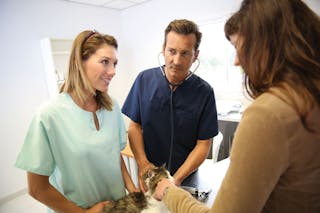
Being a good vet (Part 1)
“If your only tool is a hammer, all problems resemble a nail”. This section will stress the different factors required to make you a “good clinician”
DVM, MBA
Dr. Baralon graduated from the École Nationale Vétérinaire of Toulouse, France in 1984 and went on to study Economics (Master of Economics, Toulouse, 1985) and Business Administration (MBA, HEC-Paris 1990). He founded his own consulting group, Phylum, in 1990 and remains one of its partners to this day, acting primarily as a management consultant for veterinary practices in 30 countries worldwide. His main areas of specialization are strategy, marketing and finance, and he is also involved in training veterinarians and support staff in the field of practice management through lectures and workshop, as well as benchmarking the economics of veterinary medicine in different parts of the world. A prolific author, he has authored more than 50 articles on veterinary practice management.
Browse between the articles contributions from this author below.

“If your only tool is a hammer, all problems resemble a nail”. This section will stress the different factors required to make you a “good clinician”

Finally, some tips to improve your follow-up strategy.

This chapter will give you practical tips (what to do, what not to do, main pitfalls, etc.) on blogs, websites and social media and how to encourage clients to leave positive reviews on the web.

Based on studies on a human hospital, this chapter will outline the different steps in the pet owner journey in your practice, including the consultation that should be a “golden moment” for your client.

Internet has changed the “pet owner journey”: before telephoning a vet to ask questions or actually taking an appointment, the client will search the Internet (sometimes just to find a telephone number) and will have first information about your practice through it.

Vet practitioners are often not aware of their environment. They never stay in the waiting room of their practice for long. They sometimes even enter the practice through a different door than the one used by their clients.

Most veterinarians are not comfortable when discussing fees, or when asked to "sell" something, but this is normal! This chapter offers a method which will allow you to prescribe or recommend products and services effectively.

It’s never too early to think about the future. For many young veterinary surgeons, their job is primarily the result of a passion for pets.

Understanding the various factors involved that contribute to the income and expenditure of a veterinary clinic is key for long-term success.

This part will cover the art of communication, especially when dealing with pet owners, because nothing is more frustrating than a lack of compliance when treating an animal.

Once you've accepted a post at a practice, you'll need to learn how to manage people. You'll also need to take care of yourself to avoid burn-out. This chapter tells you how.

Even the most skilful surgeon or physician needs a good team to succeed, and as a recent graduate you will certainly want others to help and support you.
